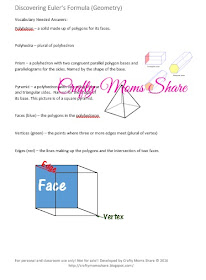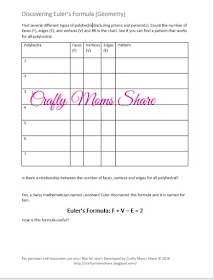This month Global Learning for Kids is exploring Switzerland. Since we explored Switzerland last year before Global Learning for Kids officially started, I thought we would focus on a Swiss mathematician. Hazel did remember some of the books and wants cheese fondue again. We did read a few of the same books and watched two DVDs (one of which we watched last year as well).
These two DVDs together gave Hazel a great overview of Switzerland. One focused more on city life and the other on the mountains. She always loves watching these DVDs and learning more about the countries.
Today we are focusing on Leonhard Euler. I searched for books about Euler and was surprised to find how little is out there for children on this famous mathematician. He is so famous he has a number named after him--the number e. You may remember e from your days working with exponents and natural logarithms. I did find one children's book on mathematics with a few pages on Euler that Hazel could somewhat understand, How to be a Math Genius written by Dr. Mike Goldsmith, Branka Surla, Consultant and illustrated by Seb Burnett.
Euler is often referred to as the greatest mathematician of the 18th century. He was the first mathematician to use f(x) notation for a function. This is something that is used all the time now. He is also said to be the first to use the Greek letter Σ for summations. Then there is the matter of the number e. He also consistently used although it was first suggested by Welsh mathematician William Jones and reportedly was the first to use i for the square root of -1. I could go on and on about his achievements but am going to focus on three. The first is the number e.
although it was first suggested by Welsh mathematician William Jones and reportedly was the first to use i for the square root of -1. I could go on and on about his achievements but am going to focus on three. The first is the number e.
Here is a lesson for you to try with your kids. You will need to have some various polyhedra (prisms and pyramids and other polyhedra will be great). The main lesson will require kids to count the faces, vertices and edges of various types of polyhedra. You can use objects you objects from around your house (blocks and boxes are great prisms) or pictures. I know I have had trouble finding a good pyramid so a picture is the way to go. Here are some to get you started.
The activity page looks like this.
In 1735 Euler gave an answer to the Königsberg Bridge Problem that started a new area of mathematics called graph theory. The problem relates to the seven bridges in the city of Königsberg, formerly in Germany and now in Russia. The problem asks to find a way to cross each bridge only once and go across each one.
Euler solved it by using graph theory and not trial and error like others were trying to do. Euler discovered it cannot be done. This is a fun problem for kids to try as well. Can they prove it is not possible?
This ends our exploration of Switzerland and Swiss mathematician Leonhard Euler. I hope you enjoyed it!! Be sure to check out all of these other great posts on Switzerland and add any you have.
These two DVDs together gave Hazel a great overview of Switzerland. One focused more on city life and the other on the mountains. She always loves watching these DVDs and learning more about the countries.
 |
| Portrait of Leonhard Euler painted by Jakob Emanuel Handmann [Public domain], via Wikimedia Commons |
Today we are focusing on Leonhard Euler. I searched for books about Euler and was surprised to find how little is out there for children on this famous mathematician. He is so famous he has a number named after him--the number e. You may remember e from your days working with exponents and natural logarithms. I did find one children's book on mathematics with a few pages on Euler that Hazel could somewhat understand, How to be a Math Genius written by Dr. Mike Goldsmith, Branka Surla, Consultant and illustrated by Seb Burnett.
Euler's Life
Euler was born in Basel, Switzerland on April 15, 1707. He showed an aptitude for mathematics at an early age and began to work with Swiss mathematician Johan Bernoulli. (The Bernoulli family has several famous mathematicians as well.) He attended the University of Basel and earned his master's degree while he was a teenager. He then went to Russia to teach at the St. Petersburg Academy. Later in his life he would be in charge of the mathematics division there. He married Katharina Gsell and they had many children, however only five lived past their father. He also later married her half sister after Katharina died. In the 1740s he was appointed the head of the mathematics division at the newly established Berlin Academy of Science and Beaux Arts. However he was not appointed the head of it by King Frederick II and he returned to St. Petersburg to head the academy there. In 1770 he had lost all of his sight. However he was able to do the mathematics and physics in his mind and continued to publish his work. He died of a brain hemorrhage in St. Petersburg the night of September 18, 1783. (Source)Some of Euler's Math Achievements
Euler is often referred to as the greatest mathematician of the 18th century. He was the first mathematician to use f(x) notation for a function. This is something that is used all the time now. He is also said to be the first to use the Greek letter Σ for summations. Then there is the matter of the number e. He also consistently used
 although it was first suggested by Welsh mathematician William Jones and reportedly was the first to use i for the square root of -1. I could go on and on about his achievements but am going to focus on three. The first is the number e.
although it was first suggested by Welsh mathematician William Jones and reportedly was the first to use i for the square root of -1. I could go on and on about his achievements but am going to focus on three. The first is the number e.The Number e
The number e is approximately 2.71828. Before Euler published about the number he would name e there was some activity around it. No one however gave it a name that stuck. During the 17th century there was work with logarithms and in 1668 German mathematician, Nicolaus Mercator published a paper that involved natural logarithm with the base being e but not using e. In 1683 Jacob Bernoulli (Johann's brother) realized that for continually compounded interest the base must be between 2 and 3. In 1684 Scottish mathematician James Gregory understood that logarithms are the inverse functions of exponential functions, but he may not have been the first to have this understanding. In 1697 Johann Bernoulli began the study of the calculus of the exponential function. Euler of course studied with Johann Bernoulli and continued his work. Euler was the first to use the letter e to describe the number and the first to show thatand that e is the limit of (1 + 1/n)n as n tends to infinity (which is what Jacob Bernoulli approximated in 1683). Euler also gave the decimal approximation of e to 18 places. No one is sure why Euler used the letter e to represent this number. There are many ideas but we will never know for sure. Today the number e is often referred to as Euler's number. (Source) Here is a page from my teaching days on exponents, logarithms and interest. This would be for older students around high school level. For a little more challenge here is a page on pi and using Euler's methods to approximate it.e = 1 + 1/1! + 1/2! + 1/3! + ...
Euler's Formula in Geometry
Euler has formulas in various topics in mathematics and physics. I thought we would look at his simple geometric formula because it is easy to understand and show to kids. Euler discovered a relationship between the faces, vertices and edges of a polyhedron. This formula works for all polyhedron that do not have a hole running through it. Euler discovered that the number of faces plus the number of vertices minus the number of edges always equals two for polyhedra. Of course to understand this one must know a bit of vocabulary. I made up a discovery lesson for you to try and it includes a blank vocabulary sheet as well as this filled in vocabulary sheet. |
| Hexagonal Dipyramid |
 |
| Heptagonal Prism By A2569875 (Own work) [CC BY-SA 3.0], via Wikimedia Commons |
Königsberg Bridge Problem
In 1735 Euler gave an answer to the Königsberg Bridge Problem that started a new area of mathematics called graph theory. The problem relates to the seven bridges in the city of Königsberg, formerly in Germany and now in Russia. The problem asks to find a way to cross each bridge only once and go across each one.
Euler solved it by using graph theory and not trial and error like others were trying to do. Euler discovered it cannot be done. This is a fun problem for kids to try as well. Can they prove it is not possible?
This ends our exploration of Switzerland and Swiss mathematician Leonhard Euler. I hope you enjoyed it!! Be sure to check out all of these other great posts on Switzerland and add any you have.








No comments:
Post a Comment
I love to hear your comments and ideas. Thank you for reading and contributing!